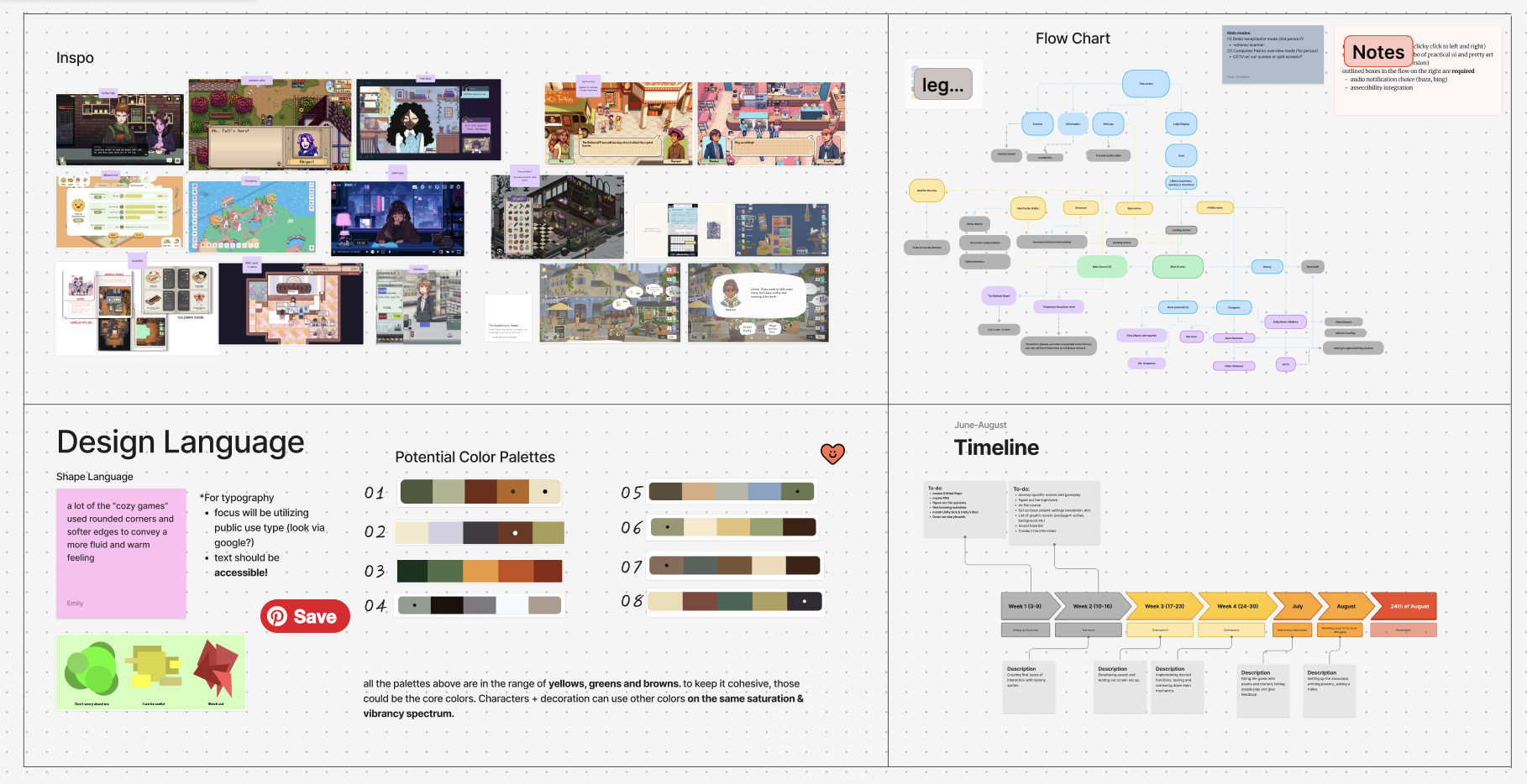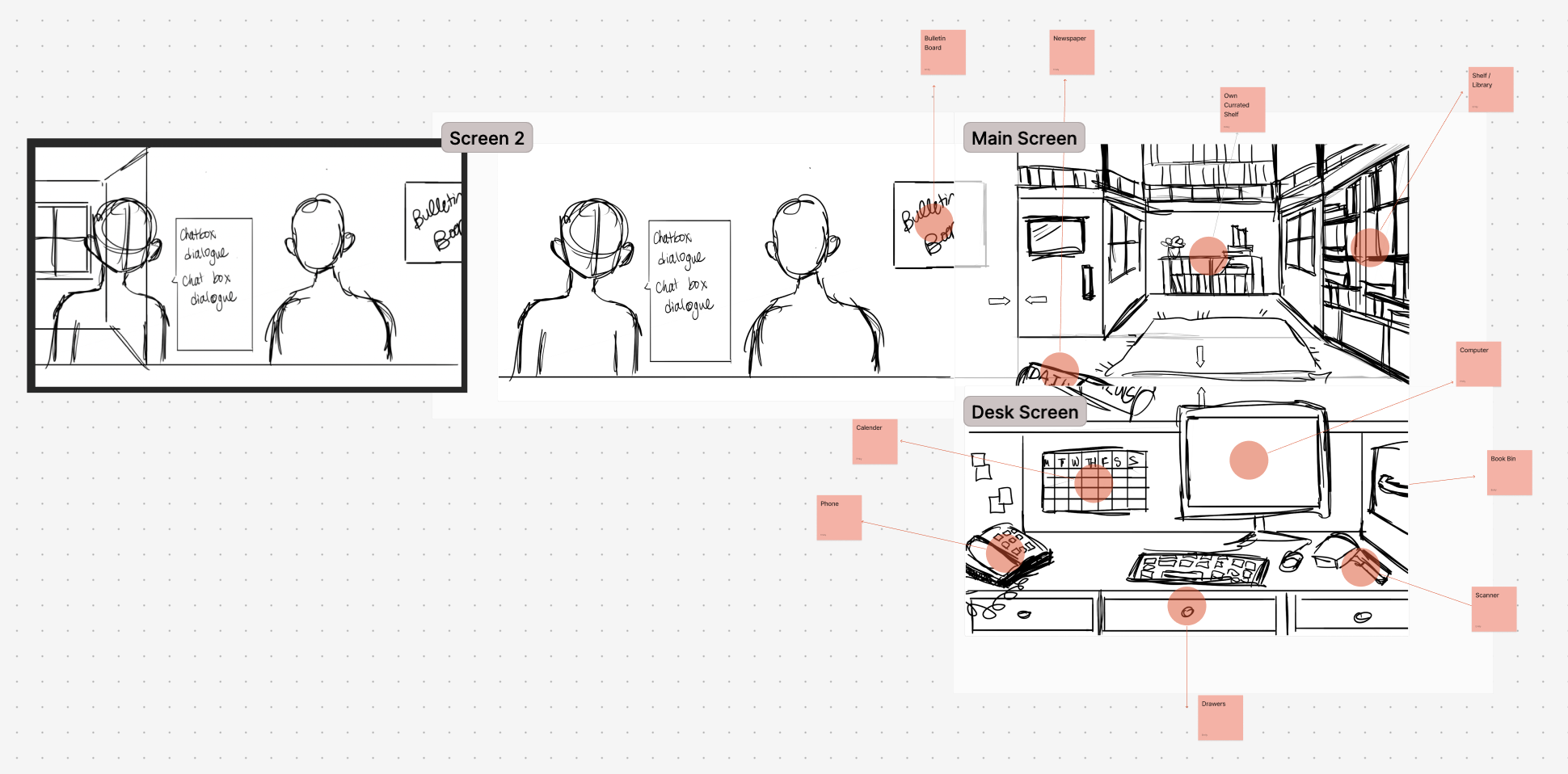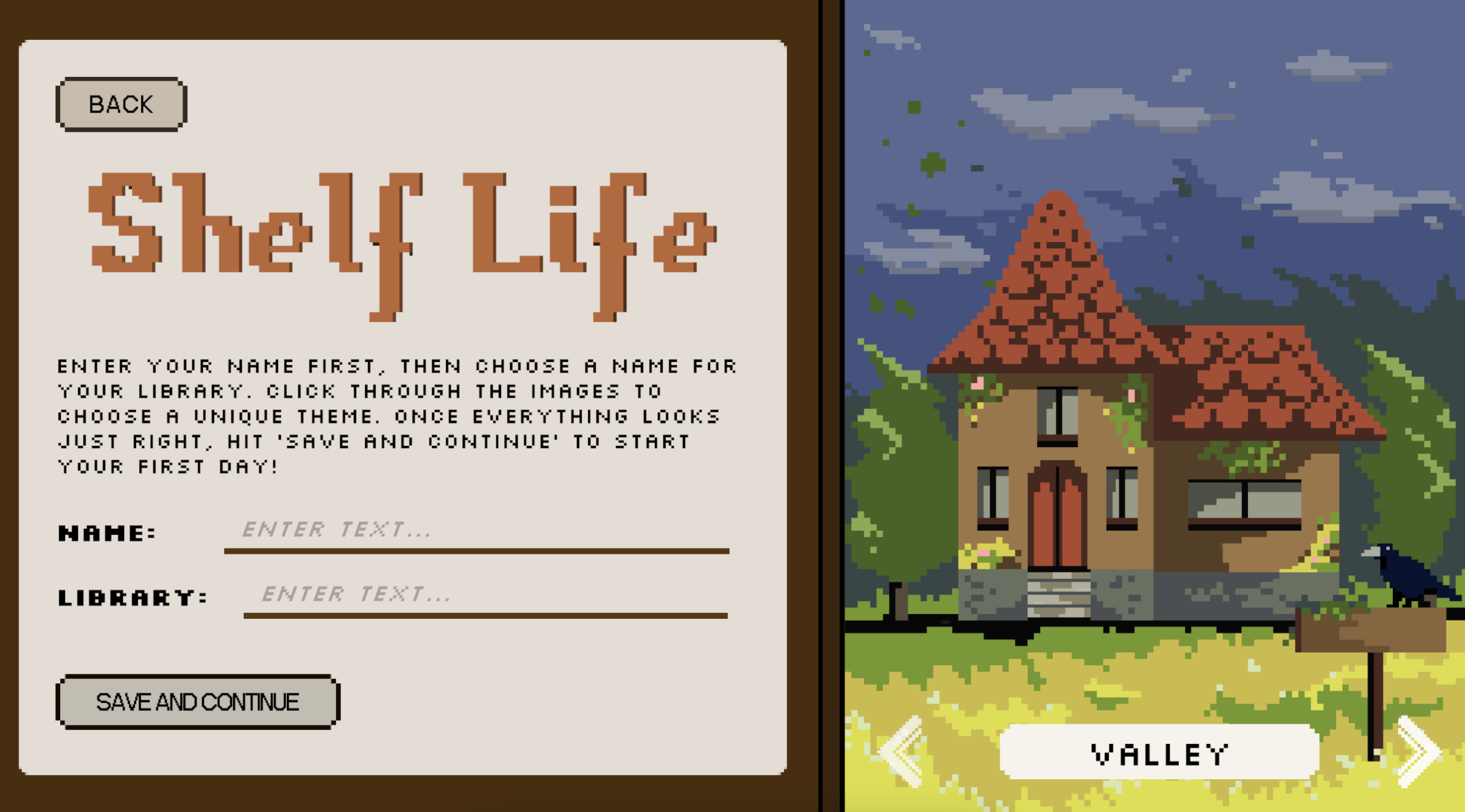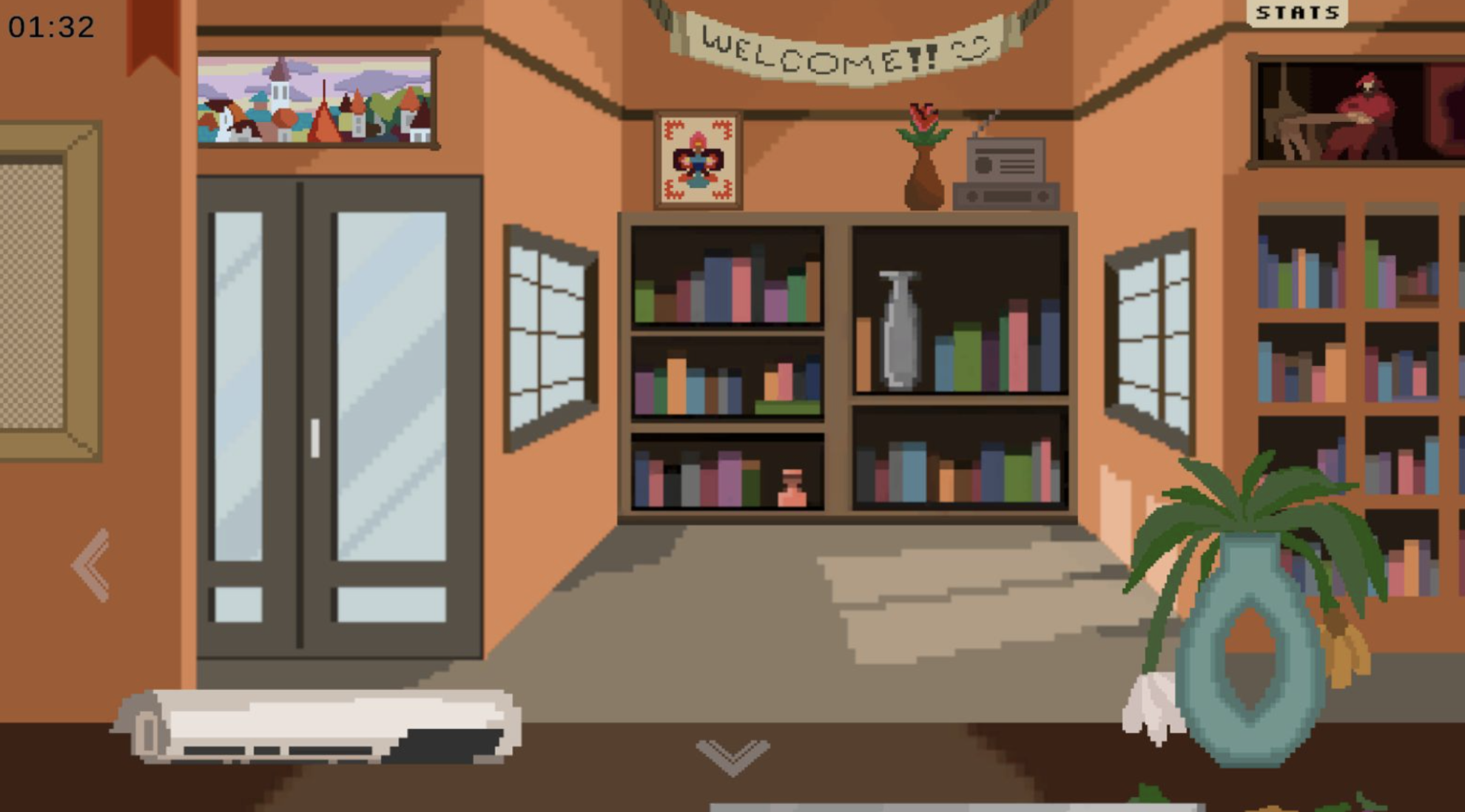Shelf Life
A narrative-driven game built in Unity, where players take on the role of a librarian restoring a neglected library and reshaping a community through meaningful choices.
time frame: 3 months
role: Lead Ux/UI Designer, Visual Designer (ProCreate, Figma), Narrative/Character Contributor, Art Direction & Branding
team: collaborated within a cross-functional team of 5.
tools: Figma · ProCreate · Adobe Photoshop · Google Docs · Unity (with team)
Project Overview
Shelf Life is a socially driven narrative game where players take on the role of a librarian working to rebuild a struggling community. The game emphasizes player choice, civic engagement, and systemic change through design.
As the Lead UX/UI Designer and Concept Artist, I was responsible for designing intuitive user flows, in-game menus, wireframes, and interaction logic. I worked closely with developers and writers to align gameplay mechanics with narrative goals, ensuring that player choices felt meaningful and integrated into the UI.
In addition to UX, I produced hundreds of visual assets, sketching, refining, and pixelating each element using Piskel while maintaining a consistent design system, visual hierarchy, and color palette to support accessibility and a cozy, immersive player experience.
Research
Our research process began with a clear goal: to create a meaningful, community-centered alternative to traditional book apps like Goodreads and Libby. Early on, we recognized that many existing platforms fell short in fostering genuine engagement or delivering transparent, trustworthy recommendations. We wanted to design a platform that not only served individual readers but also strengthened the relationship between public libraries and their communities, creating real-world social impact.
To build a strong foundation for Shelf Life, I took several concrete steps:
01. Leveraged my membership in Trinity College Dublin’s prestigious literary society, where I conducted in-depth interviews with publicists, editors, and authors. These conversations provided valuable professional perspectives on how readers discover books, what they seek in digital tools, and the limitations of current library and book apps.
Problem Statement / Design Challenge
Public libraries are underutilized by younger readers, often due to outdated digital interfaces. We wanted to design a platform that reintroduces libraries as engaging, modern spaces. How might we design a game experience that encourages critical thinking about public services, community engagement, and individual agency; all while being visually compelling and intuitive to play?
02. Performed a detailed competitive analysis of popular book apps such as Goodreads, Libby, and BiblioCommons. Through this, we identified common pain points like the prevalence of biased or anonymous reviews, lack of authentic community interaction, and opaque recommendation algorithms that often left users feeling disconnected or mistrustful.
03. Explored user frustrations and desires by researching discussion forums, social media groups, and reader communities. This desk research helped us build proto-personas reflecting diverse reader profiles and their unique needs, such as casual browsers, students, and socially conscious readers.
04. Reached out to my personal professional network to gather interdisciplinary feedback. We employed a qualitative research approach through targeted interviews with librarians based in Trinity College, as well as across the U.S. and Europe. These conversations provided direct insights into real-world library systems, user behaviors, and service gaps. In parallel, I tapped into my personal network, including a Netflix director with narrative design expertise and a Seattle-based game designer, to refine the user journey. Their feedback helped shape mechanics that balance gameplay and storytelling, ensuring the experience stayed grounded, engaging, and player-focused.
Discovery
As a team, we synthesized these insights and agreed on four core design pillars that would guide every aspect of the product:
Social Impact: Fostering civic participation and community empowerment.
Community Engagement: Encouraging users to interact, share, and connect authentically.
Real-World Book Integration: Incorporating actual library book inventories and curated reading lists.
Accessibility: Designing for diverse users and ensuring the platform is a valuable resource for public libraries.
This thorough, multi-faceted research approach allowed us to move beyond simply digitizing a catalog or replicating existing apps. Instead, we designed Shelf Life as an interactive game that cultivates connection, discovery, and a renewed love for books, all grounded in the tangible, real-world context of libraries and communities.
UX/UI Ideation & Design Process 🔧
Our design process began with extensive sketching to explore layout ideas and user flows grounded in accessibility best practices. Early concepts were primarily hand-drawn, allowing us to rapidly iterate and visualize key screens and interactions without being limited by software constraints.
Color played a significant role in setting the tone and identity of the game. I led multiple color palette explorations, collaborating closely with my four teammates to test and refine combinations that balanced the warmth of classic library interiors with the playful charm of children’s literature. This iterative approach helped us land on palettes that felt both inviting and visually distinct.
To deepen player engagement, we designed the experience around a choice of three distinct libraries, each set in a unique location. These choices influenced the game's visual aesthetic and soundtrack, providing personalized atmospheres based on the player’s early library selection. This feature required close alignment with the narrative team; I worked alongside the narrative designers to map out plot progression, determining how many screens and UI states would be needed to support branching storylines.
Throughout the design cycle, we produced numerous iterations, moving from rough paper sketches to more refined digital wireframes and mockups in Figma. Recognizing the tight three-month development window, we adopted a “content-first” mindset, creating ample assets and narrative material early on to enable cutting content later, rather than scrambling to produce new elements under time pressure.
Collaboration with the developer was also integral. I maintained constant communication to ensure that every asset I created was compatible with the game’s structure and mechanics, guaranteeing that visuals and UI components were not just decorative but functional parts of the gameplay experience.
To keep the entire team aligned and on track, we held weekly meetings focused on in-person collaboration, with online sessions as needed to accommodate all team members. These meetings were essential for setting clear goals, assigning deadlines, and ensuring open communication across disciplines, enabling us to efficiently manage tasks and maintain steady progress throughout the project.
Early research and palette exploration.
Moodboard research of library interiors across the world.
Screen interfaces and mechanics required to make the game function with the players. Notes reviewed with team to ensure it tied in with the narrative design.
Concept 1: Minimalist Direction. An early approach focused on minimal movement and monochrome visuals to subtly reflect the tone of uncertainty between gameplay chapters.
Concept 2: Narrative-Driven Symbolism. Explored loading visuals using iconography relevant to library culture to keep storytelling consistent, even in transitional spaces.
Concept 3: Interior Library. This foreshadows the library interior and creates the coziest atmosphere. This was the most favored screen!
Bonus: Early Wireframe Mockup Low-fidelity wireframe showing how the main screen could appear with all necessary components as a rough.
Phone Interaction UI. Designed a call system where players engage with characters using a retro-inspired mobile interface, enhancing narrative depth and choice-based gameplay.
Desk Inventory System. Built a clean, readable inventory screen to help players track collected items and clues. Prioritized visual clarity and ease of access within a cozy, pixel-based layout.
Desk Inventory System. Further iteration on the Desk Inventory system early concept and design roughs on how the system would function for ease of use!
A full-color version of the original sketch for the player’s main UI inventory hub. This stage emphasized accessibility and narrative texture, balancing cozy aesthetics with mechanical clarity.
Interactive Plant Mechanic – Visual Reference. An early system concept where a flower grows or withers depending on player decisions. Acts as a soft, ambient feedback loop that visualizes civic and ethical choices without traditional stats, reinforcing emotional impact over gamification.
Early concept character roughs with variation of poses and emotes to help better engage the characters with the players!
Our final design phase involved hundreds of iterative refinements; hand-drawn sketches, digital mockups, and prototypes that were rigorously reviewed and discussed among our team and industry professionals from the games sector. This ongoing dialogue ensured our design decisions were both creative and practical, pushing the project toward a polished, cohesive experience.
A key focus was the seamless integration of all visual elements with the game’s codebase. I worked rigorously alongside the developer to ensure that every asset was optimized and fully functional within the game mechanics, leaving no detail overlooked. Additionally, I collaborated closely with the sound engineer to synchronize the visual components with the evolving soundscape, creating an immersive and harmonious player experience.
Much of this final work was the result of hours of detailed discussion, iteration, and hands-on development, demonstrating our commitment to quality and cohesion across all aspects of the game’s design.
Final User Interface Design ✨
Opening Title Screen. A polished start screen that sets the narrative tone and introduces the game’s visual identity.
Library Exterior Selection. An interactive screen for navigating the library’s evolving exterior, with changing soundscapes and visual states based on player actions.
Main Landing Screen. Main interface maintaining immersion while signaling transitions between key moments.
Dialogue & Choice Screen. Dynamic dialogue UI featuring branching options that influence narrative and character relationships.
Dialogue & Choice Screen. Dynamic dialogue UI featuring branching options that influence narrative and character relationships.
Poster & World Assets. In-game visual assets used to build atmosphere and reinforce the library's evolving identity with each poster tied to an in game character
Graffiti Event Interface. A reactive moment-based screen where players must respond to unexpected events through intuitive UI prompts.
Desk & Inventory Interface. The player’s primary hub for managing items, documents, and tasks. This was designed for clarity and efficiency.
Newspaper Interaction Mechanic. A world-building UI element that allows players to engage with contextual story updates through an in-game newspaper.
End-of-Day Summary Screen. A reflective interface that communicates the consequences of player decisions at the close of each in-game day.
Final Character Roster. All characters available for interaction through the game. Every play through will have different characters!
Outcome / Impact
🎓 Public Showcase (Graduation Demo)
Over 100+ attendees, including educators, children, and industry guests
Children as young as 12 navigated the interface independently
Multiple users stayed engaged for 45+ minutes without tutorial guidance
📈 UX/UI Highlights
Interfaces like the dialogue system, withering flower mechanic, and inventory desk were praised for clarity and emotional resonance
Visual storytelling allowed complex topics (ethics, community, care) to be accessible
Onboarding and feedback loops enabled players to feel agency and understanding within 2 minutes of starting the game
📣 Feedback Highlights
"The design made me think deeply about my community." – Showcase Attendee
"My students would love this as a tool for ethical reading." – Teacher
"Looks polished enough to be a real release." – Industry guest
✅ Key Outcomes
Users expressed strong interest in more gameplay content and extended story development, showing enthusiasm to dive deeper into the narrative.
Minor bugs related to dialogue and text display were identified and require fixing to improve user experience.
Given more time, we would expand on the game mechanics to increase interactivity and player agency beyond the existing demo.
Despite a tight three-month development schedule, we successfully created a robust 1-hour demo showcasing core features and gameplay.
Several players asked about potential publication platforms (e.g., Steam) and funding options like Kickstarter, indicating market interest.
The inclusion of real-world, publicly available book listings was highly appreciated by users, who valued the authentic connection to actual library resources.























